The x86 Power Myth Busted: In-Depth Clover Trail Power Analysis
by Anand Lal Shimpi on December 24, 2012 5:00 PM ESTThe untold story of Intel's desktop (and notebook) CPU dominance after 2006 has nothing to do with novel new approaches to chip design or spending billions on keeping its army of fabs up to date. While both of those are critical components to the formula, its Intel's internal performance modeling team that plays a major role in providing targets for both the architects and fab engineers to hit. After losing face (and sales) to AMD's Athlon 64 in the early 2000s, Intel adopted a "no more surprises" policy. Intel would never again be caught off guard by a performance upset.
Over the past few years however the focus of meaningful performance has shifted. Just as important as absolute performance, is power consumption. Intel has been going through a slow waking up process over the past few years as it's been adapting to the new ultra mobile world. One of the first things to change however was the scope and focus of its internal performance modeling. User experience (quantified through high speed cameras mapping frame rates to user survey data) and power efficiency are now both incorporated into all architecture targets going forward. Building its next-generation CPU cores no longer means picking a SPECCPU performance target and working towards it, but delivering a certain user experience as well.
Intel's role in the industry has started to change. It worked very closely with Acer on bringing the W510, W700 and S7 to market. With Haswell, Intel will work even closer with its partners - going as far as to specify other, non-Intel components on the motherboard in pursuit of ultimate battery life. The pieces are beginning to fall into place, and if all goes according to Intel's plan we should start to see the fruits of its labor next year. The goal is to bring Core down to very low power levels, and to take Atom even lower. Don't underestimate the significance of Intel's 10W Ivy Bridge announcement. Although desktop and mobile Haswell will appear in mid to late Q2-2013, the exciting ultra mobile parts won't arrive until Q3. Intel's 10W Ivy Bridge will be responsible for at least bringing some more exciting form factors to market between now and then. While we're not exactly at Core-in-an-iPad level of integration, we are getting very close.
To kick off what is bound to be an exciting year, Intel made a couple of stops around the country showing off that even its existing architectures are quite power efficient. Intel carried around a pair of Windows tablets, wired up to measure power consumption at both the device and component level, to demonstrate what many of you will find obvious at this point: that Intel's 32nm Clover Trail is more power efficient than NVIDIA's Tegra 3.
We've demonstrated this in our battery life tests already. Samsung's ATIV Smart PC uses an Atom Z2760 and features a 30Wh battery with an 11.6-inch 1366x768 display. Microsoft's Surface RT uses NVIDIA's Tegra 3 powered by a 31Wh battery with a 10.6-inch, 1366x768 display. In our 2013 wireless web browsing battery life test we showed Samsung with a 17% battery life advantage, despite the 3% smaller battery. Our video playback battery life test showed a smaller advantage of 3%.
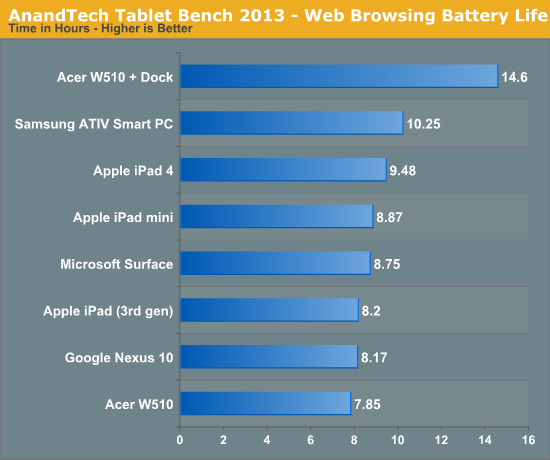
For us, the power advantage made a lot of sense. We've already proven that Intel's Atom core is faster than ARM's Cortex A9 (even four of them under Windows RT). Combine that with the fact that NVIDIA's Tegra 3 features four Cortex A9s on TSMC's 40nm G process and you get a recipe for worse battery life, all else being equal.
Intel's method of hammering this point home isn't all that unique in the industry. Rather than measuring power consumption at the application level, Intel chose to do so at the component level. This is commonly done by taking the device apart and either replacing the battery with an external power supply that you can measure, or by measuring current delivered by the battery itself. Clip the voltage input leads coming from the battery to the PCB, toss a resistor inline and measure voltage drop across the resistor to calculate power (good ol' Ohm's law).
Where Intel's power modeling gets a little more aggressive is what happens next. Measuring power at the battery gives you an idea of total platform power consumption including display, SoC, memory, network stack and everything else on the motherboard. This approach is useful for understanding how long a device will last on a single charge, but if you're a component vendor you typically care a little more about the specific power consumption of your competitors' components.
What follows is a good mixture of art and science. Intel's power engineers will take apart a competing device and probe whatever looks to be a power delivery or filtering circuit while running various workloads on the device itself. By correlating the type of workload to spikes in voltage in these circuits, you can figure out what components on a smartphone or tablet motherboard are likely responsible for delivering power to individual blocks of an SoC. Despite the high level of integration in modern mobile SoCs, the major players on the chip (e.g. CPU and GPU) tend to operate on their own independent voltage planes.
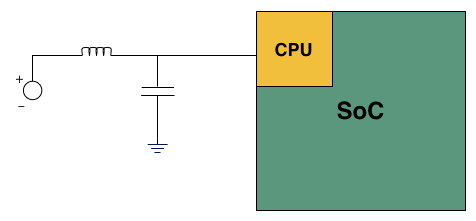
A basic LC filter
What usually happens is you'll find a standard LC filter (inductor + capacitor) supplying power to a block on the SoC. Once the right LC filter has been identified, all you need to do is lift the inductor, insert a very small resistor (2 - 20 mΩ) and measure the voltage drop across the resistor. With voltage and resistance values known, you can determine current and power. Using good external instruments you can plot power over time and now get a good idea of the power consumption of individual IP blocks within an SoC.
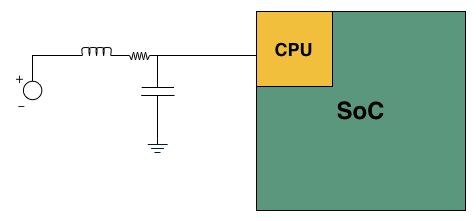
Basic LC filter modified with an inline resistor
Intel brought one of its best power engineers along with a couple of tablets and a National Instruments USB-6289 data acquisition box to demonstrate its findings. Intel brought along Microsoft's Surface RT using NVIDIA's Tegra 3, and Acer's W510 using Intel's own Atom Z2760 (Clover Trail). Both of these were retail samples running the latest software/drivers available as of 12/21/12. The Acer unit in particular featured the latest driver update from Acer (version 1.01, released on 12/18/12) which improves battery life on the tablet (remember me pointing out that the W510 seemed to have a problem that caused it to underperform in the battery life department compared to Samsung's ATIV Smart PC? it seems like this driver update fixes that problem).
I personally calibrated both displays to our usual 200 nits setting and ensured the software and configurations were as close to equal as possible. Both tablets were purchased by Intel, but I verified their performance against my own review samples and noticed no meaningful deviation. All tests and I've also attached diagrams of where Intel is measuring CPU and GPU power on the two tablets:

Microsoft Surface RT: The yellow block is where Intel measures GPU power, the orange block is where it measures CPU power
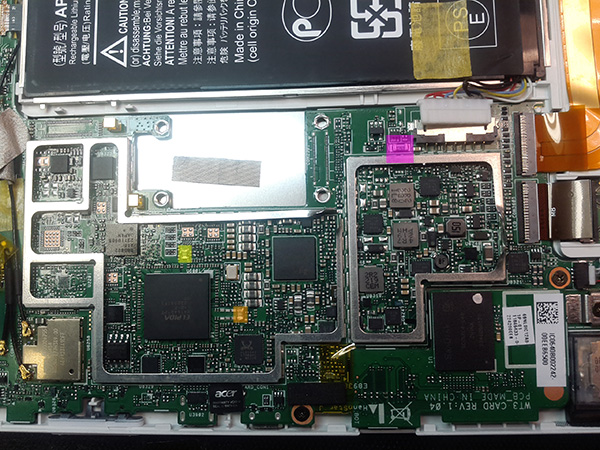
Acer's W510: The purple block is a resistor from Intel's reference design used for measuring power at the battery. Yellow and orange are inductors for GPU and CPU power delivery, respectively.
The complete setup is surprisingly mobile, even relying on a notebook to run SignalExpress for recording output from the NI data acquisition box:
Wiring up the tablets is a bit of a mess. Intel wired up far more than just CPU and GPU, depending on the device and what was easily exposed you could get power readings on the memory subsystem and things like NAND as well.
Intel only supplied the test setup, for everything you're about to see I picked and ran whatever I wanted, however I wanted. Comparing Clover Trail to Tegra 3 is nothing new, but the data I gathered is at least interesting to look at. We typically don't get to break out CPU and GPU power consumption in our tests, making this experiment a bit more illuminating.
Keep in mind that we are looking at power delivery on voltage rails that spike with CPU or GPU activity. It's not uncommon to run multiple things off of the same voltage rail. In particular, I'm not super confident in what's going on with Tegra 3's GPU rail although the CPU rails are likely fairly comparable. One last note: unlike under Android, NVIDIA doesn't use its 5th/companion core under Windows RT. Microsoft still doesn't support heterogeneous computing environments, so NVIDIA had to disable its companion core under Windows RT.


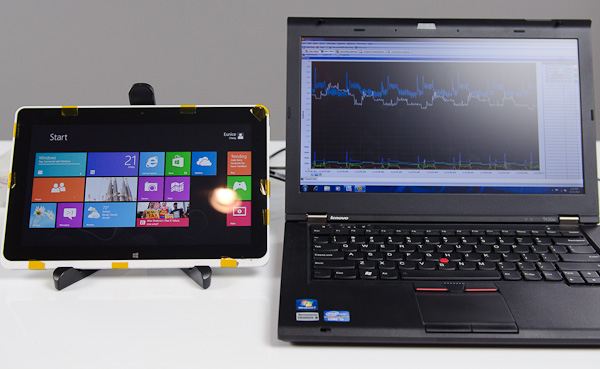
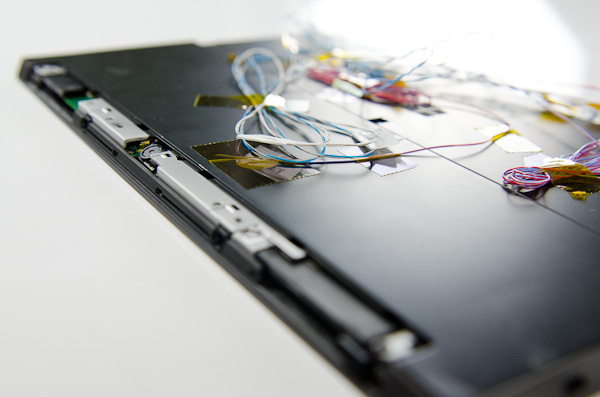
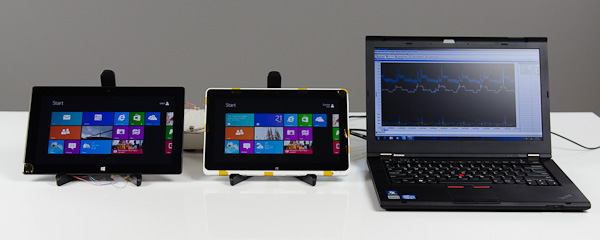














163 Comments
View All Comments
runner50783 - Monday, December 24, 2012 - link
This is why I don't care if you post your podcast on time : P, you guys are the best when it comes to technical analysis and reviews, you are the reference for the rest of the review sites, keep it up!Well, I guess graphics power may be the only advantage of tegra 3 over clover trail right now, and that may change with proper drivers too... Now it really makes little sense to have an RT based system, I feel bad for pulling the trigger on a Surface RT after playing with a Clover trail tablet, it was much faster on almost everything except games.
designerfx - Tuesday, December 25, 2012 - link
This is the first time in a long while that I've seen Anandtech declare that something which isn't accurately measured, is actually accurately measured and compared.I'm quite disappointed, honestly. 5th core on the Tegra is a significant part of what defines its power savings, and yet they're saying "Welp. It's about the same!".
I'm really questioning this a lot, Anand.
Deo Domuique - Thursday, December 27, 2012 - link
This is his yearly fat bonus by Intel :PAs for us, just ignore it and move on.
MrSpadge - Saturday, December 29, 2012 - link
What the ...?! If there's currently no way to enable the 5th core in Win 8, what exactly are they supposed to do? I'm sure Anand would love to repeat these tests if any way to fix this was available.. but right now that's how both devices perform. Call Tegra 3 crippled on Win 8 if you want, as that's what it apears to be.Activate: AMD - Saturday, December 29, 2012 - link
Whats the problem? They're comparing performance under the windows RT environment and Anand mentions on the very first page:"One last note: unlike under Android, NVIDIA doesn't use its 5th/companion core under Windows RT. Microsoft still doesn't support heterogeneous computing environments, so NVIDIA had to disable its companion core under Windows RT."
The only thing thats disappointing here is your inability to comprehend whats being tested.
Wolfpup - Thursday, January 3, 2013 - link
That would improve idle performance, but this is a real world test for the time being, and even still-Atom is more powerful, and yet uses less power, AND of course because it's more powerful, finishes doing work faster.Even if that fifth core were supported, this is still quite nifty.
The fact that I can, today, buy an actual x86 PC that can easily double as an iPad class ebook reader/light web browsing tablet is just amazing. (eInk's better, but you know what I mean).
Alexvrb - Thursday, December 27, 2012 - link
I'm not a huge fan of Tegra 3, but I wouldn't regret your Surface purchase too much. My dad has one, it's built better than any other tablet I've held. Plus Inte's solution is almost entirely unsatisfactory for 3D gaming. Intel is only using a single SGX 545 core. They clock it pretty high, but it isn't enough. The latest iPad uses a 4-core SGX 554 solution, and clocked right it seems to do pretty darn good on power too. Clocks aren't as high but it blows both the Tegra 3 and any ULV Atom out of the water.I'm not a huge fan of Apple either, but they generally use the most cutting-edge Imagination Technologies IP available. That might include Rogue (Series 6) in the next go around... Intel needs to get Series 6 in their chips ASAP.
Oh, and graphics drivers? Intel? Good luck! If this was Nvidia or AMD I might have agreed with you.
ssj3gohan - Monday, December 24, 2012 - link
This is really pornographic power electronics stuff. I do this stuff every day with my ultra-power efficient computer projects, but I didn't know that Intel walked around with this kind of a setup to show transparently what they are doing with power consumption.Good work, Intel. Now go and apply your knowledge to desktop platforms as well, because I'm kicking your ass here. I have yet to come across a desktop platform that cannot be made at least 50% more power efficient just through power electronics hacks.
madmilk - Monday, December 24, 2012 - link
Did anyone honestly think Intel, with a hundred times the revenue of ARM, would let themselves be devoured?Intel will still trouble entering the mobile device market because of the ISA lock-in ARM enjoys. On the other hand, ARM at this moment does not stand a chance in the (micro)server market either, especially as Intel increases its server Atom line.
tipoo - Monday, December 24, 2012 - link
Yeah, I think Intel will do fine and remain the 900lb gorilla in the mobile arena as well. ARM has the lead now, but once Intel has its sights set on something vital to its interests it tends to destroy the competition.